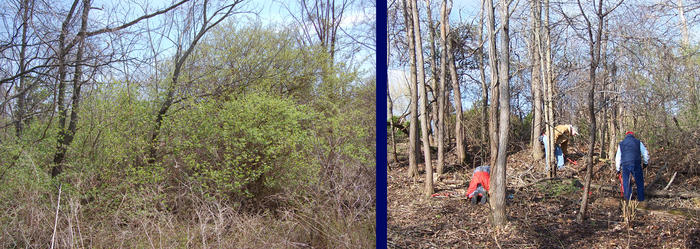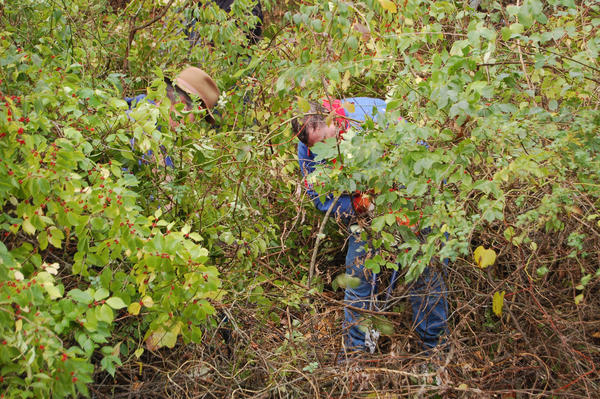(For a general overview of the problem created by invasive species, visit our invasive species page.)
A Reason For Concern
Some plants, when introduced into a habitat where they were not native, begin to push out the native plants that were originally growing in the area. Invasive plants are usually very aggressive growers, highly adaptable to a wide range of conditions, and have a longer growing season. They out-compete other plants for resources such as water and sunlight, and in some cases they can actually strangle the native plants.

Amur honeysuckle creates dense shrub thickets, preventing other plants from growing underneath. Photo courtesy of Dr. Brent C. Blair, Xavier University.
As these plants invade the area, the shift in vegetation can have dramatic consequences in the overall ecosystem of the area. As honeysuckle outcompetes other plants, especially those smaller than itself, there will be very little other vegetation in the lower layers of the forest. Some invasive plants also release allelopathic chemicals into the soil to prevent other types of plants from growing. Seedlings of the canopy trees are also affected, so the forest will have less ability to regenerate itself as the older trees age and die. A native forest with many species of canopy trees, understory trees, shrubs, and herbaceous plants will become much less diverse in each layer.
When the original vegetation is degraded, the natural services it provided will also be affected. Storm water may not be held back and absorbed as efficiently, causing higher water flow and more erosion in local streams. The smaller invasive plants will sequester less carbon and produce less oxygen than the larger native trees they excluded. Some plants, such as kudzu are being studied as contributors to air pollution and smog problems. Public health problems, particularly respiratory issues, can suffer as a result of these additional burdens.
As the invasion continues and the plant diversity is lowered, there will be a reduction of habitat for the local wildlife. Increased competition for food and shelter among animals will force those animals to look elsewhere, perhaps even into your own yard, for the resources they need. With fewer individual animals able to survive, the overall animal biodiversity will also be reduced.
Invasive plants can also negatively impact the economic value of the land. Farmers' crops will have smaller yields and produce less income. A forest with fewer trees, or trees that are growing improperly, will become less valuable for the timber industry. With a lowered diversity of plants and animals, the recreational value of an area will become less attractive to visitors and local tourism will begin to decline. The vines of kudzu and Japanese honeysuckle will begin to create tripping hazards, and may eventually completely hide the hiking trail.

Volunteers helping dramatically transform the arboretum's invasive species demonstration area. Photo courtesy of Josh Selm, Boone County Arboretum.
The Invasive Plant Awareness Trail
In 2010, Friends of Boone County Arboretum received a grant from the US Forest Service, through the Kentucky Division of Forestry, to create an invasive plant removal demonstration trail. The main trail was created and many invasive plants were removed in the spring of 2011, but maintaining the area free of invasive plants will be an ongoing task. If you are interested in volunteering to help maintain this or other areas of the arboretum, please contact the arboretum staff.
Our Native Plants Are At Risk
The plants in our native woodland areas are threatened by invasive plants taking over their habitat. Here are some of the invasive plants of concern at BCA: Japanese honeysuckle, Amur honeysuckle, kudzu, ornamental pear (a KY-EPPC Least Wanted Plant), and garlic mustard. Each of these are either present within our facilty, or can be found nearby.
In addition to the challenges posed by plants that are invasive, our native plants are also under attack by invasive pests and diseases. Chestnut blight, Dutch elm disease, emerald ash borer, and Asian longhorn beetle are among the most notable.
Poison hemlock (Conium maculatum) is a highly poisonous, herbaceous, biennial flowering plant in the carrot family (Apiaceae). It is native to Europe and North Africa, and has become invasive in the U.S. It grows 5-8 feet tall, with an appearance similar to Queen Anne’s Lace (Daucus carota), except poison hemlock has a smooth, hairless, green, hollow stem, usually spotted or streaked with red or purple. The leaves are two- to four-pinnate, finely divided and lacy, overall triangular in shape. The flowers are small, white, clustered in umbels up to 4-6 in across. The plant will emit a rank, unpleasant odor when crushed, and all parts are poisonous to ingest or touch; wear gloves and limit exposure when removing. Poison hemlock flourishes in early spring and is usually dying back by early summer when Queen Anne’s Lace is starting to become showy. Poison hemlock should also not be confused with the coniferous eastern hemlock tree, Tsuga canadensis, which is completely unrelated. Image courtesy of Josh Selm, Boone County Arboretum.
Things You Can Do To Help
Everyone:
Volunteer with natural resource agencies to control invasive species. Educate yourself and keep up to date on the status of these and other pests. Learn to identify the invasive species in your area and avoid passing through them. Report any occurrence of invasive species to your local county extension agent, State Forestry Division office, or to other state or local natural resource or agricultural agencies. The sooner invasive species are detected, the easier and cheaper it is to control them.
Spread the word; tell others about invasive species, especially if invasive species are on their land. Don't move firewood. Buy firewood from areas close to where you will be using it. Burn everything before returning home (don't take it with you, don't leave it behind).
Homeowners / Small-plot Gardeners
Do not empty aquariums or dump houseplants or pets into the wild. Remove and control populations of invasive species on your own land. Until you are able to rid your garden of invasive plants, be responsible and remember to remove and destroy seed heads before they can spread.
Do not plant or move an invasive species, avoid using invasive species at all costs. Check to see if a plant is invasive before planting it. There is a wide variety of beautiful, easy to care for native plants available as alternatives. Think about the characteristics of the invasive plant you are replacing. Look for an alternative plant list for your state/region and talk to your local native plant society or exotic pest plant council. These organizations will be able to suggest suitable native replacements.

Join a volunteer group to remove honeysuckle, multiflora rose, and other invasive plants from public properties. Image courtesy of Josh Selm, Boone County Arboretum.
To avoid spreading seed of invasive plants, learn to recognize infestations and avoid passing through them. Don't share invasive plants with other gardeners, but rather talk to them about invasive species and how you plan to help in the fight against them.
Outdoor Enthusiasts / Hunters / Campers:
To avoid spreading seed of invasive plants, learn to recognize infestations and avoid passing through them. Don't move firewood. Buy and use firewood that is close to your campsite. Burn everything before returning home (don't take it with you, don't leave it behind).
Between trips, or preferably before leaving an infested area, be sure to clean your boots, shoes and brush off your clothes after being in an area with invasive species. Clean your gear, truck bed, tires and equipment after working a site. Remove all seeds and other plant parts to prevent spreading seeds, insects or spores to a new location.
Before leaving a body of water, drain all water from your boat, motor, bilge, live well, and bait containers access. Remove visible plants, animals and mud from your boat. Dispose of unwanted bait in the trash, and never release plants or animals into a body of water unless they came from that body of water. Before entering another body of water, be sure to clean and dry the boat and equipment.
Additional Information
Visit the www.invasive.org website and the National Invasive Species Information Center. The Kentucky Exotic Pest Plant Council and their Least Wanted Plant program are excellent reference sites about invasive plants. Utilize the National Tree Benefit Calculator to determine the value of your tree lot, and the Kentucky Division of Forestry for additional resources and management plans. Also check out the Continental Dialogue on Non-Native Forests Insects and Diseases.

